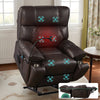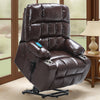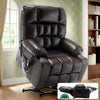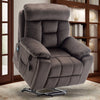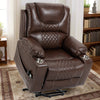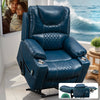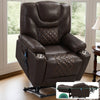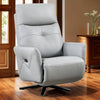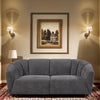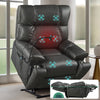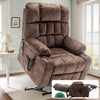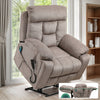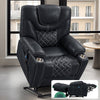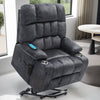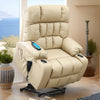Introduction to Power Lift Chairs: A Tool for Independence
The Evolution of Power Lift Chairs in Home Care
Power lift chairs have come a long way in home care. They started as simple recliners with basic lift functions. Now, they are high-tech aids for the elderly and those with mobility issues.
Early models were bulky and limited in features. Today's chairs are sleek and packed with options. They offer multiple positions, massage features, and heating elements.
The controls have also improved. From basic remotes to voice commands and smartphone apps. This makes them easier to use for those with limited dexterity.
Manufacturers now focus on comfort and style, not just function. Power lift chairs blend in with home decor. They no longer look like medical equipment.
Safety features have also advanced. Many chairs now have backup power and anti-tip designs. This gives users and caregivers peace of mind.
Benefits of Power Lift Chairs for the Elderly Population
Power lift chairs offer many benefits for older adults. They promote independence and improve quality of life. Here's how they help:
- Easier Standing and Sitting: The lift function gently raises users to a standing position.
- Reduced Fall Risk: By assisting with transitions, these chairs lower the chance of falls.
- Comfort and Pain Relief: Multiple positions help ease joint pain and improve circulation.
- Better Sleep: Some models recline fully, offering a comfortable sleeping option.
- Increased Independence: Users can change positions without help from caregivers.
- Improved Mental Health: Greater mobility often leads to better mood and less isolation.
- Caregiver Support: These chairs reduce the physical strain on family members and caregivers.
Power lift chairs also help with daily activities. They make it easier to watch TV, read, or engage in hobbies. This keeps seniors active and engaged in their homes.
For those with conditions like arthritis or COPD, these chairs offer relief. They can adjust to find the most comfortable position for breathing or joint comfort.
Expert Insights into the Design and Functionality of Reviline Lift Systems
Key Features That Make Reviline Lift Systems Stand Out
Reviline Lift Systems are known for their innovative design and user-friendly features. Here's what sets them apart:
- Smooth Lift Mechanism: Reviline chairs use advanced motors for gentle, quiet movement.
- Multiple Position Memory: Users can save their favorite positions for quick adjustments.
- High-Quality Upholstery: Durable, easy-to-clean fabrics that withstand daily use.
- Ergonomic Design: Chairs are shaped to provide optimal support for various body types.
- Advanced Remote Control: Large buttons and clear labels make operation simple.
- Safety Sensors: Built-in technology prevents accidents during lifting or reclining.
- Customizable Options: Users can choose from various sizes and styles to fit their needs.
Reviline also offers unique features like USB charging ports and built-in heat therapy. These add convenience and comfort for users.
The company focuses on accessibility. Their chairs are designed to be easy to use for those with limited mobility or vision issues.
Reviline's attention to detail extends to the chair's base. It's stable and designed to work on various flooring types without damage.
How Reviline Lift Systems Are Enhancing Aging in Place
Reviline Lift Systems play a crucial role in supporting aging in place. They allow seniors to stay in their homes longer and more comfortably.
These chairs promote independence by making daily tasks easier. Getting up from a seated position becomes effortless. This encourages more movement and activity throughout the day.
Reviline chairs adapt to changing needs. As mobility decreases, the chair's features can be adjusted. This means it remains useful even as health conditions evolve.
The chairs reduce the risk of falls, a major concern for aging in place. By providing stable support during transitions, they create a safer home environment.
Reviline systems integrate well with other home care technologies. They can be part of a larger smart home setup for aging adults.
These chairs also support caregivers. They reduce the physical strain of helping someone stand or sit. This can prevent caregiver burnout and injury.
For those with chronic conditions, Reviline chairs offer comfort management. The ability to easily change positions helps with pain relief and circulation.
By improving comfort and mobility, these chairs often lead to better sleep. Good rest is crucial for overall health and well-being in older adults.
Implementing Power Lift Chairs in Home Care: Best Practices
Training Caregivers on Power Lift Chair Usage
Proper training for caregivers is essential when introducing power lift chairs. It ensures safety and maximizes the benefits of these devices.

Key training points include:
- Understanding Chair Controls: Caregivers should be familiar with all functions and settings.
- Safety Procedures: Teaching proper transfer techniques and emergency protocols.
- Maintenance and Cleaning: Regular upkeep to keep the chair in good condition.
- Customizing Settings: Adjusting the chair to meet individual user needs.
- Recognizing Warning Signs: Knowing when the chair needs service or repair.
- Patient Education: Teaching users how to operate the chair independently when possible.
- Proper Positioning: Ensuring users sit correctly to prevent discomfort or injury.
Hands-on practice is crucial. Caregivers should practice using the chair themselves before assisting others.
It's important to cover the limitations of the chair. Caregivers need to know when additional help is needed for transfers or movement.
Regular refresher courses can help keep skills sharp and introduce new features or best practices.
Assessing the Impact of Power Lift Chairs on Mobility and Quality of Life
Evaluating the effectiveness of power lift chairs is important for ongoing care. It helps justify their use and improve implementation.
Methods for assessment include:
- Mobility Surveys: Tracking changes in the user's ability to move independently.
- Fall Incident Reports: Monitoring any decrease in falls after chair implementation.
- Pain and Comfort Scales: Assessing if the chair reduces discomfort or pain.
- Activity Logs: Noting changes in daily activities and engagement levels.
- Sleep Quality Reports: Checking if the chair improves rest and sleep patterns.
- Caregiver Feedback: Getting input on how the chair affects care routines.
- User Satisfaction Surveys: Gathering direct feedback from those using the chairs.
Regular check-ins with users and caregivers can provide valuable qualitative data. This helps identify any issues or needed adjustments.
Physical therapists or occupational therapists can offer professional assessments. They can evaluate how the chair impacts overall mobility and function.
Long-term tracking is key. The full benefits of power lift chairs may become more apparent over time as users adjust to them.
Comparing pre and post-implementation data can show clear improvements in quality of life. This information is valuable for healthcare providers and families.
By carefully assessing impact, care teams can optimize the use of power lift chairs. This ensures they truly enhance mobility and support successful aging in place.








